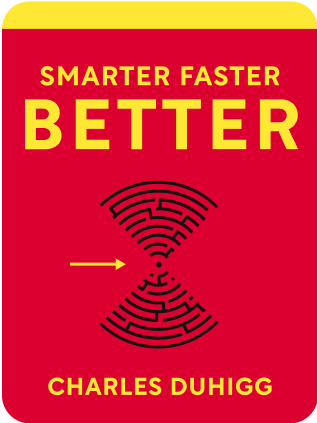

This article is an excerpt from the Shortform book guide to "Smarter Faster Better" by Charles Duhigg. Shortform has the world's best summaries and analyses of books you should be reading.
Like this article? Sign up for a free trial here .
Could your personal productivity use a boost? Would you like to learn how to get more done?
In Smarter Faster Better, Charles Duhigg discusses six principles that he believes are crucial to improving personal productivity. He argues that it’s not about working longer hours or constantly pushing yourself to do more. Instead, it’s about making wise choices in certain areas of your life.
Read more to discover ways to improve personal productivity.
6 Principles for Improving Personal Productivity
Many of us wish that we could become more productive. However, it’s not always clear how to do this. Here are six principles that provide insight and direction.
Principle #1: Find Motivation
The first principle that is important in improving your personal productivity is finding motivation. If you lack motivation, you’re more likely to procrastinate your tasks and less likely to complete your work to a high standard. You may struggle to find the drive to pursue your goals. This ultimately harms your personal productivity.
Research has suggested that there are two things you can do to improve your motivation. Firstly, you can make choices that help you to feel in control. Even making a small choice about the task in front of you, such as deciding to respond to a particular email first, can help you to feel in control of a situation. In turn, this feeling of control will increase your confidence, make you more willing to push yourself, and boost your motivation.
The second action you can take to generate motivation is finding meaning in your choices. Sometimes, simply making a choice isn’t enough to increase your motivation, especially when the task in front of you is difficult or unpleasant. However, reminding yourself of the meaning behind your choices—why you’re doing what you’re doing—can give you the boost you need to get started. If you link a difficult task to a higher purpose, it can become more palatable and you can become more motivated to complete it.
Principle #2: Maintain Focus
Another important facet of personal productivity is maintaining focus on your tasks. If you constantly get distracted from your most important work, your productivity will suffer.
Two cognitive processes can harm your ability to focus. The first process is cognitive tunneling. If you enter a cognitive tunnel, your brain becomes hyper-focused on an immediate and obvious stimulus, such as an email you’ve just received, at the expense of everything else that’s going on around you.
The second harmful process is reactive thinking. When you think reactively, the brain responds automatically to a certain stimulus or event using a familiar mental process. For instance, if you’re driving and begin to approach a red light, your brain may instinctively tell you to start braking.
These cognitive processes can forcibly drag you away from your most productive path. After all, the most immediate and obvious stimulus may not be the one you need to focus on to get your work done. Likewise, thinking reactively becomes unproductive when the brain selects an inappropriate reaction to your current situation.
Triggers and Solutions
Cognitive tunneling and reactive thinking are often triggered when the brain has to jump from a relaxed state to a focused state quickly or unexpectedly, or when you’re feeling stressed or overwhelmed.
How can you avoid these harmful cognitive processes and teach yourself to focus? Psychologists believe that creating mental models can help you to stay on track.
Mental models are stories that you create about the world around you. You may internally narrate a story about what you’re experiencing in real-time. For example, during a meeting, you may create an internal narrative of who is speaking, what they’re saying, and how other participants are responding to their points. Narrating your life like this prevents your brain from slipping into a fully relaxed state. This makes its transition into “focused mode” much smoother and averts the panic that can cause unhelpful cognitive processes to take hold.
You can also create mental models that outline your expectations for the future. You can decide in advance what your goals for a certain period will be and what you need to do to meet these goals. When it’s time to put your plan into action, you know exactly what you need to focus on to maintain your personal productivity. If distractions crop up that don’t fit into your original mental model of the day, you can identify them quickly and choose whether to address them or dismiss them.
Principle #3: Set Effective Goals
Setting effective goals is another principle you need to implement if you want to increase your personal productivity. You need to have a clear idea of what you’re working towards. You also need to make sure that you’re aiming for the right results.
There are two types of goals that you can use to enhance your productivity: stretch goals and SMART goals.
Stretch goals are far-reaching objectives that, at first glance, may not even seem possible. They’re ambitious and audacious, and often require a lot of forethought and effort to achieve.
In contrast, SMART goals are targeted and focused objectives that often represent the smaller steps you’ll need to take to meet your stretch goals. SMART goals must be specific; measurable; achievable; realistic; and timely.
For stretch and SMART goals to be effective, they must be used together. For instance, you may choose to set an ambitious stretch goal and then break it down into actionable steps using SMART goals.
If a stretch goal is used alone, it can become too overwhelming for you to work towards. If SMART goals are used alone, you may fall into the trap of “cognitive closure”—a mental process that makes you focus more on the satisfying feeling of completing your goals, and less on the actual productivity or usefulness of those goals.
While you’re pursuing your goals, you must constantly evaluate whether these goals are still the best way forward. You should consider whether new information has rendered your goals inappropriate or unproductive so you don’t blindly pursue goals that, while initially well-intentioned, have become unproductive.
Principle #4: Make Productive Decisions
An important element of personal productivity is making productive decisions: decisions that help you to achieve your goals. At the root of productive decision making is the ability to predict the future with some accuracy. You need to be able to forecast what the consequences of your decisions will be, and, based on this, whether you should pursue a certain course of action or not.
Probabilistic Thinking
Predicting the future is by no means easy. Nobody can do so accurately all of the time. However, there are ways for you to increase the accuracy of your predictions. For example, you can use probabilistic thinking. Studies have shown that this type of thinking can increase the accuracy of predictions by as much as 50%.
Probabilistic thinking is a cognitive approach that involves identifying all of the possible futures that a decision could lead to and calculating the odds of each future coming to pass. You can use this information to decide whether to proceed with the decision or not.
However, probabilistic thinking isn’t infallible. You may struggle to find the information you need to make an accurate estimation of the odds of each future coming true. In cases such as this, it may be helpful to pair your probabilistic thinking with another cognitive approach: Bayesian cognition.
Bayesian Cognition
Bayesian cognition involves using your assumptions about the world and how it operates to make accurate predictions. Your brain forms these assumptions based on experiences that you internalize and patterns that you notice. When you’re faced with a situation that seems to fit a previously observed pattern, you can apply your assumptions to predict, hopefully accurately, how this situation will progress.
It’s important to note that Bayesian cognition only helps to make your predictions more accurate if your assumptions are accurate. If you base a prediction on a flawed assumption, it follows that the prediction will be flawed, too.
Principle #5: Become a Productive Innovator
An innovator is someone who formulates fresh and exciting ideas. You may not think of yourself as an innovator, but innovation is likely a crucial aspect of your job. If you make your creative process more productive, you’ll increase your overall productivity. But what makes a productive innovator?
To innovate in a productive way, you need to come up with ideas in a timely manner without compromising on quality. Implementing four principles can help you to do this.
#1: Combine Old Ideas in New Ways
Firstly, you can combine old ideas in new ways. For instance, Benjamin Spock combined two existing ideas—traditional childcare methods and Freudian psychological theories—to innovate his best-selling work, The Common Sense Book of Baby and Child Care.
This is much quicker than trying to come up with completely new ideas. However, it still retains the creative element that distinguishes innovation from simply copying someone else’s ideas.
#2: Use Your Past Experiences and Emotions to Validate and Generate Ideas
Secondly, you can use your past experiences and emotions to validate and generate ideas. You can use your emotions to check whether the old ideas you’re using are of a high quality, or if they’re just tired clichés. How you feel about those ideas—whether they feel fresh or just predictable—will help you to decide whether they’re usable or not.
For example, the creator of West Side Story, Jerome Robbins, instructed his co-writers to completely re-write the show’s opening because after reading it, he felt that it was too predictable and, therefore, boring. The opening scene went from being a traditional discussion between characters to an iconic and revolutionary communication of ideas through dance.
You can also use your past emotions and experiences as inspiration for new ideas. These ideas are almost guaranteed to feel genuine; after all, they’re based on your real life.
#3: Embrace Frustration and Anxiety as Fuel for New Ideas
The third principle you can follow is embracing frustration and anxiety as fuel for new ideas. For instance, if you’re feeling frustrated about a certain area of your life, innovate a solution to relieve this irritation. You might just come up with the next big idea.
Needing to innovate quickly can leave us feeling anxious. This anxiety can cause us to enter a state called “creative desperation.” In this state, we spend our time frantically searching for a good idea. We desperately formulate unusual combinations of old ideas in the hope that we strike gold. By doing this, we might just stumble upon an amazing idea that we would have otherwise ignored.
#4: Remain Open to Alternative Ideas
The final principle that can help you to innovate productively is remaining open to alternative ideas. When you’ve finally innovated an amazing new concept, you may shut yourself off to new ideas. You might become so focused on the idea you’ve already come up with that you refuse to consider that there might be a better approach out there. This can cause problems if you’re only midway through the creative process and need to keep innovating to meet your goal.
You can force yourself to remain open to alternative concepts by making an effort to re-examine your ideas. In doing so, you recognize that there may be a way to make your idea even better. You should also try to retain emotional distance from your ideas to prevent yourself from becoming too attached to them.
Finally, in a team environment, you may be able to restart the innovation process by slightly adjusting the dynamic of the team. By moving people into slightly different roles, you force them to look at ideas from a new perspective. This creates the conditions for innovation to thrive once more.
Principle #6: Use Data Productively
The final principle that can help you to improve your personal productivity is using data productively. In our technologically advanced society, we’re surrounded by data almost all of the time. However, simply having access to this data doesn’t guarantee we’ll use it productively. We may even become so overwhelmed by the amount of data out there that we stop taking it in. We enter a state of information blindness.
To avoid information overload and interact productively with the data that you need and that interests you, you need to do something with it. This could mean writing out the information by hand, plotting it on a graph, or explaining the information to another person.
Interacting with data in this way is sometimes called “creating disfluency.” Disfluency involves adding extra effort to the process of absorbing information, thus making the process a bit more difficult. Adding this effort and difficulty requires you to consider the data more deeply and pay extra attention to it. You process the data in a thorough way, leading to the information sticking in your brain.
Using Data to Solve Problems and Make Better Decisions
Another way to use data productively is to use it to solve problems and make decisions. You can do this using the engineering design process.
The engineering design process requires you to consider all of the available data before making a decision or solving a problem. You can then use this data to formulate different approaches to your dilemma. Finally, you can evaluate which approach is likely to see the greatest success.
Using the process helps you to break free of one of the brain’s unhelpful automatic processes: trying to streamline decision making as much as possible. The brain loves to simplify things and often uses a limited frame of reference to view decisions and problems. It tries to resolve these issues based on just one or two variables. In contrast, the engineering design process encourages you to analyze all of the different variables that may affect your choice, a process similar to probabilistic thinking. You’re more likely to make a good decision if you use this thorough approach.
Follow these six principles, and you are sure to improve your personal productivity and get more done every day.

———End of Preview———
Like what you just read? Read the rest of the world's best book summary and analysis of Charles Duhigg's "Smarter Faster Better" at Shortform .
Here's what you'll find in our full Smarter Faster Better summary :
- Why becoming more productive isn’t about working longer hours or constantly pushing yourself to do more
- The 8 principles for improving productivity
- How to create a work culture in which each employee is truly valued






